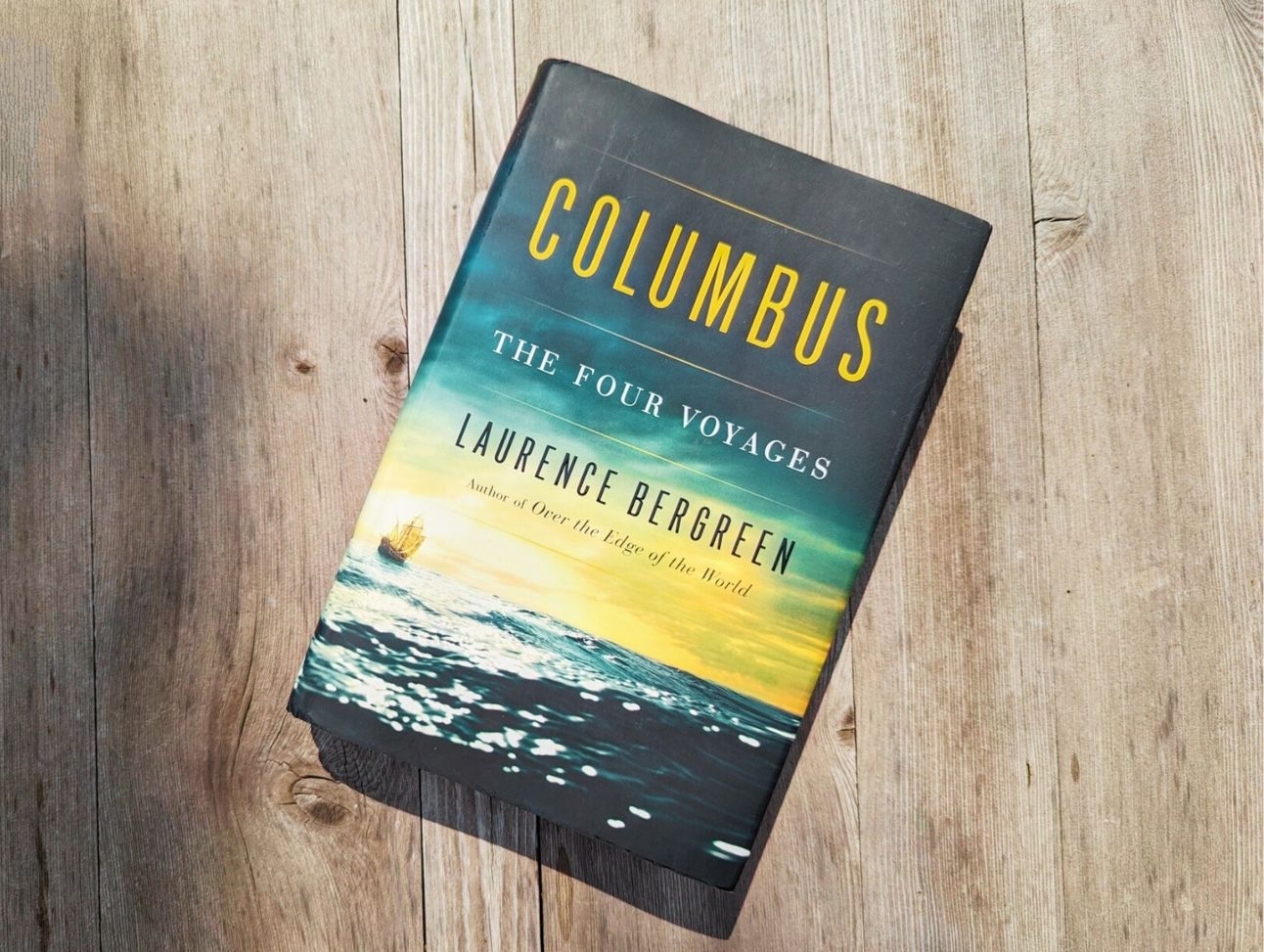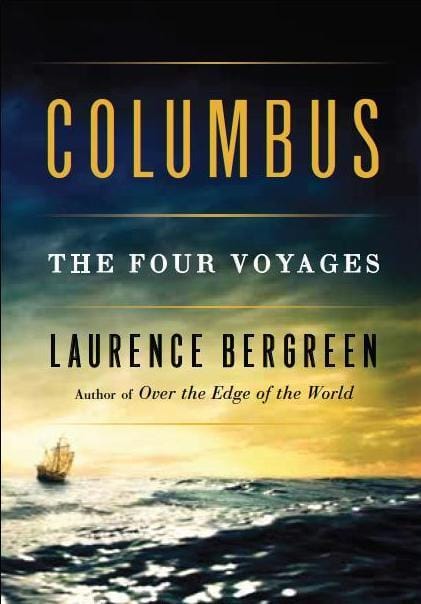
Laurence Bergreen’s 2012 book is a biography of Columbus as told through the lens of the four voyages he made to the New World.
We are all familiar with Columbus’s first voyage when he captained the small fleet made up of the Pinta, the Niña and the Santa Maria. Setting sail from Granada in Spain, Columbus and his men made landfall in Hispaniola (the island today split between the nations of Haiti and the Dominican Republic).
Columbus set sail westward searching for a shorter route to the fabulous wealth that lay east of Europe in India and China - hoping specifically to call on the court of “the Great Kahn” who Marco Polo had known as the ruler of China, and who was said to have access to large quantities of gold.

Beautiful Art for the Hardcover Dust Jacket created by Backscatter Graphics
The first voyage commenced on August 3, 1492. After stopping on the island of Gran Canaria for four days in September for repairs to the Pinta, the crew set sail again. Twenty-nine days later Columbus and his men landed at Hispaniola on October 12, 1492.
Bergreen repeatedly comes back to Columbus’ navigational skills. He did not rely on the stars and the sextant to steer a course, unlike many captains of his day. His long experience at sea had taught him to navigate by “an inborn sense of the sea, of wind and weather”. Scholars still debate whether the hazy navigational instructions included in his reports to the Spanish sovereigns were attempts to keep his destinations secret from others, or whether they in fact reflected Columbus’s instinctual wayfinding.
But what isn’t disputed is the fact that, even after other Spanish captains started following in his wake, Columbus’s navigational skills and seamanship meant that he had shorter passage times and was better at handling rough seas and weather than many of his competitors.

One of many plates in the book, this is the Maggiolo world map from about 1511 which includes (on the left hand side) parts of Brazil and the islands found by Columbus
Columbus’s relationship with King Ferdinand and Queen Isabella were strained after he returned from his first voyage. He had not found the route to the court of the Great Khan that he had promised. For the rest of his life Columbus was engaged in rearguard actions to protect his reputation - pleas to the King and Queen to respect the titles and promises they had made to him and to keep competitors away from the lands he had discovered.
Columbus, Bergreen points out, was motivated not a little by the potential for riches. On Hispaniola he found the Tianos, a settled people, and their antagonistic and cannibalistic neighbors the Caribs. Living in a tropical climate the natives went about unclothed and had no weapons to counter the Spanish muskets. Interfering into the affairs of the two peoples from the start, by his second voyage Columbus and his men began to enforce a tribute system on the entire populace. Every Indian over the age of 14 was required to pay a “hawk’s bell filled with gold” each year.
Spaniards began taking slaves from among the local population. Skirmishes between the locals and the Spaniards became common, often ending in gruesome deaths for the locals. All of this led to famine among the Indians, who were too busy searching for gold to tend their crops. More than 50,000 died either through hunger or mass suicide. (Many jumped from cliffs to their deaths knowing they could not feed their families and being unable to find the tribute of gold on an island that, it turns out, does not have a lot of the metal.)
Columbus’s third voyage ended with him shipped back to Spain in shackles for his mismanagement of the lands he had discovered - he had allowed rebellion among the Spaniards he oversaw. He was also criticized for allowing slavery of the Indians instead of conversion to Christianity. He was replaced as leader of the Spaniards in the New World. No official attention seemed to have been paid to the deaths of thousands of the native people.
At the start of his fourth voyage in 1502, Columbus, now 51, was a half-blind arthritic old man. The sovereigns had reluctantly agreed to fund one more venture, but as Bergreen notes, it became “the wildest, most reckless, and grimmest voyage of them all”. The entire flotilla was stranded in Jamaica for a year. After rescue by the governor in Hispaniola, Columbus, having lost all his ships, had to pay his way back to Spain.

Historian and author Laurence Bergreen
Columbus died in May 1506. Despite the fact that the lands he reached had not appeared on any map, Columbus was always sure he was on the right track and would find his way to China if he continued to search. He remained convinced that China was nearby throughout all four voyages, and likely until his death. It would be left to another Spanish explorer, Vasco Núñez de Balboa to become the first European to encounter the Pacific Ocean from the western shores of Central America. China lies another 9000 miles by sea to the west.
Bergreen covers all four voyages along with the time spent onshore in the New World with great detail, relying on the records left behind by Columbus and others to craft his story. He does a masterful job, but the story is a bit dry. I put down and picked up this book several times, and its 370 odd pages took me several days to work through.
RATING: Four Stars ⭐⭐⭐⭐
Rating Comments: A must for anyone wanting to understand Columbus the man, or for those interested in the European conquest of the new world. Thorough and well researched if a bit dry.
NOTE: The hardcover edition I read appears to no longer be available, but you can find the book in paperback, ebook and audiobook.
Steve's Book Stuff participates in affiliate programs for the booksellers asterisked below. Purchases you make through an affiliate link will return a small commission to me, at no additional cost to you.
Borrow or Buy Columbus: The Four Voyages here:
📙Borrow this book: Find out if your library is lending this book through Libby.
📘 Buy this book: Amazon | Barnes & Noble | Books-A-Million | Powell’s | AbeBooks* | ThriftBooks
📗 Support Indie Bookstores: Buy this book directly from Bookshop.org*.
📚 Visit my Bookshop.org shop to see all my reviewed books.
Title: Columbus: The Four Voyages
Author: Laurence Bergreen
Publisher: Viking Penguin (Penguin Random House)
Publish Date: September 25, 2012
ISBN-13:
Hardcover ISBN-13: 978-0670023011 (out of print)
Paperback ISBN-13: 9780143122104
Audiobook ISBN-13: 9781101523681
Publisher’s List Price: $17.95 (Paperback)
